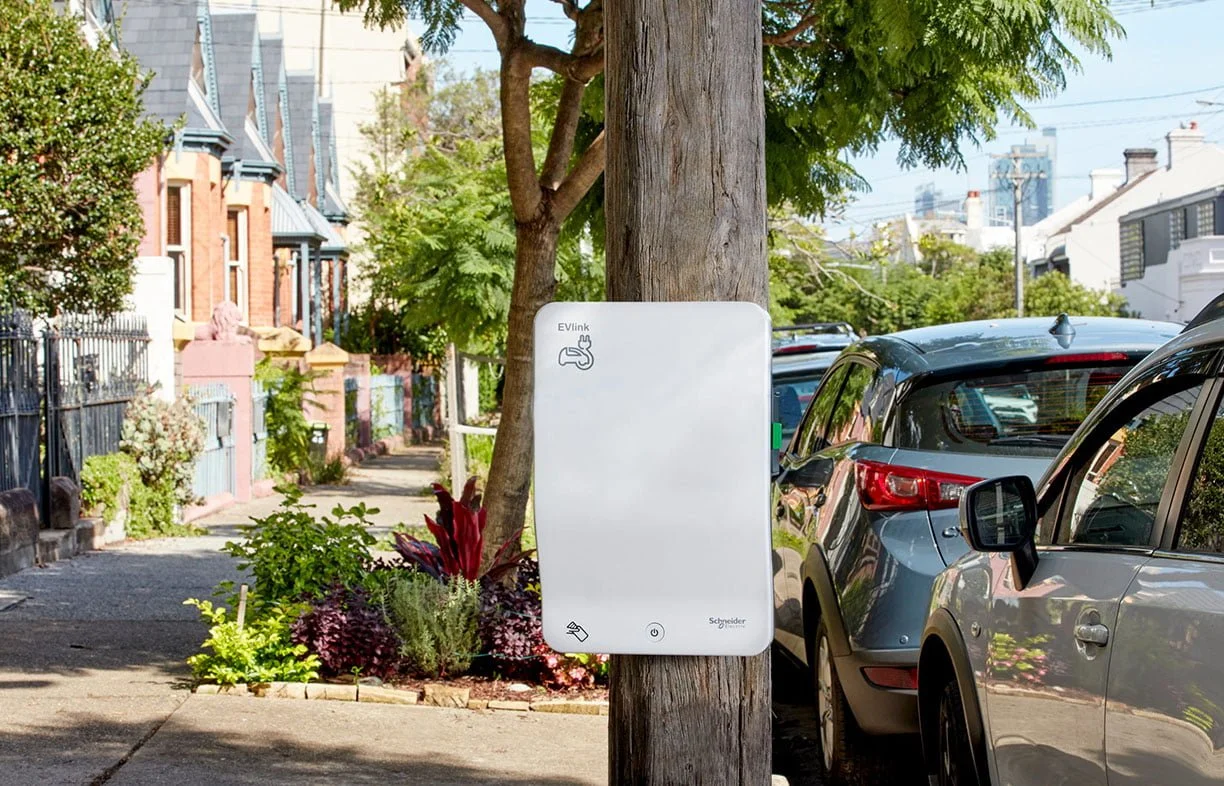Offsetting EV energy at home

Electric vehicles are finally emerging in Australia. A recent Renew study explores to what extent solar PV and energy storage can offset an EV’s grid energy usage and bills.
Renew has been studying the environmental and economic impacts of all-electric homes for several years now, with our 2018 report showing that new all-electric homes with solar PV can save thousands over 10 years compared to dual-fuel homes.
As electric vehicles emerge as a viable option in Australia, the obvious next question to consider is how an EV impacts on the all-electric home’s bills and carbon footprint.
A recent Renew study has looked at this in the context of The Cape, an efficient, all-electric housing development of 230 homes at Cape Paterson, on Victoria’s south-east coast. The Cape’s developer was interested in how adding an EV to these high efficiency homes would affect both bills and emissions. They asked: with a suitably sized solar PV and battery system and an EV, is it possible to reduce household and transport bills and grid imports for a high efficiency home to zero, and to achieve net zero carbon?
Scenarios and energy use
Renew modelled two hypothetical scenarios based on standard Cape houses: a small 135 m2 8 Star home with low mileage for the location (15,000 km/year) and a large 195 m2 8 Star home with high mileage (40,000 km/year). For each of these scenarios, the team used Sunulator, Renew’s solar and battery sizing tool, to calculate the impact of different-sized solar PV systems and household batteries on bills, grid import and carbon footprint.
Key to the analysis was a model of driving patterns for the two households, and an EV charging profile for each.
For Scenario 1, the modelled driving pattern included two short local trips per week (20 km and 40 km), a fortnightly trip to Melbourne (300 km) and a monthly regional trip of 400 km. Allowing for a four-week holiday each year with no EV driving, these trips came to an annual mileage of 15,440 km. For Scenario 2, the modelled driving pattern substituted the fortnightly trip with two trips per week to Melbourne.
Carbon emissions
Annual CO2 emissions saved by a solar system are estimated by multiplying solar electricity generation by the grid’s average emissions intensity (across all centralised generators). If a battery is present, this is adjusted by subtracting energy wasted in losses charging and discharging the battery.
Annual net carbon is estimated by subtracting the solar system’s CO2 saving from the property’s estimated emissions without a solar system. A negative value is a beneficial result for the environment.
Renew then developed a charging profile for each of these trips, assuming a 7 kW EV charger. Charging for the shorter trips was timed to start around midday, while the longer trips would mean charging at night, starting at 5 pm after arriving home.
Renew added these EV charging profiles to household energy usage profiles for the two 8 Star houses (assuming use of heat pumps for hot water, heating and cooling) to give an overall energy usage profile.
For Scenario 1, over a year, energy use averaged 19.05 kWh/day (household: 11.45 kWh, vehicle: 7.6 kWh). For Scenario 2, energy use was considerably higher, averaging 38.36 kWh/day (household: 19.12 kWh, vehicle: 19.24 kWh).
Renew modelled a range of solar PV and solar–battery systems against that annual load to test the ability of each system to meet the load. The modelling was done on a 30-minute basis to give an accurate picture of on-site usage of the solar and battery energy, along with export to and import from the grid.
To determine the cost impact, a mid-level flat tariff (based on those available in the Cape Paterson area) was used: 30 c/kWh for imports, 12 c/kWh feed-in tariff and $1.10/day fixed charge.
| BAU | 5 kW | 10 kW | 5 kW+5 kWh | 5 kW+13.5 kWh | 10 kW+13.5 kWh | |
|---|---|---|---|---|---|---|
| Environment Results | ||||||
| Annual CO2 saved (T) | – | 7.1 | 14.2 | 6.9 | 6.8 | 13.9 |
| Annual net carbon (T) | 8.07 | 0.97 | – 6.13 | 1.17 | 1.27 | – 5.83 |
| System sizing statistics | ||||||
| Self-consumption of solar | 29% | 17% | 59% | 73% | 39% | |
| Solar export % | 71% | 83% | 41% | 27% | 61% | |
| Average battery utilisation | 0% | 0% | 100% | 56% | 58% | |
| Export to grid (kWh/day) | 13.78 | 32.36 | 8 | 5.24 | 23.55 | |
| Import from grid (kWh/day) | 19.05 | 13.38 | 12.53 | 8.14 | 5.65 | 4.54 |
| Financial stats | ||||||
| Solar/battery cost | $6500 | $12000 | $13500 | $17000 | $22000 | |
| Annual electricity bill | $2487 | $1264 | $356 | $942 | $791 | -$133 |
| Annual maintenance cost | $50 | $100 | $100 | $100 | $130 | |
| Annual total cost | $2487 | $1314 | $456 | $1042 | $891 | –$3 |
| Annual bill saving | $1173 | $2031 | $1445 | $1596 | $2490 | |
| Net present value (20 years) | $9434 | $15440 | $3968 | $1550 | $8688 | |
| Simple payback (years) | 6 | 6 | 10 | 16 | 9 | |
| Return on investment | 15.9% | 14.6% | 5.7% | 3.5% | 6.7% |
Table 1. Scenario 1 results for the small house with low mileage. BAU is without a solar or solar–battery system. Net carbon emissions close to zero or even negative are achieved with all systems. Financial payback is fastest (six years) for the two solar-only systems. Results for larger systems and different charging profiles are in the full report.
Scenario 1: Small house, low mileage, big savings
Table 1 (above) shows the results for Scenario 1.
– Cost savings
For this small house with low mileage, significant cost savings are able to be achieved. With no solar or battery, the annual electricity bill of the Scenario 1 home would be $2487 per year. Adding a 5 kW solar-only system reduces this to $1264 per year, a saving of $1173 with a simple payback of six years. The 10 kW solar-only system reduces the annual electricity bill to just $356. Even allowing for maintenance costs, the annual savings from this system are over $2000. The 10 kW solar/13.5 kWh battery system sends bills negative, with annual savings of $2490 and a simple payback of nine years.

– Grid imports
The system that reduces the use of grid electricity the most is the largest solar–battery system modelled: 10 kW solar/13.5 kWh battery. This system reduces grid imports by 14.51 kWh/day to an average of 4.54 kWh/day, a 76% reduction.
The 5 kW solar-only system reduces grid imports by around 30%. The home still requires an average of 13.38 kWh/day from the grid. The 10 kW solar-only system still requires an average 12.53 kWh/day from the grid, around a 35% reduction.
The variability of the loads is one of the factors affecting battery utilisation and hence grid imports. For the 10 kW/13.5 kWh system, the battery is only 58% utilised on an average daily basis. For some days of the year, the load is relatively small and the battery is only partially discharged, while on the days where significant EV charging occurs (after one of the longer trips), the battery cannot supply sufficient energy and grid imports are required.
– Net carbon emissions
Both of the systems with 10 kW of solar (solar-only or solar and battery) achieve negative net carbon emissions; the emissions reduction from these systems is larger than the emissions associated with the imports from the grid.
The systems with 5 kW of solar (either solar-only or solar and battery) do not quite achieve net zero carbon; each of these scenarios result in around one tonne of emissions per year. However, this is still a significant reduction from the 8 tonnes of carbon without solar or battery, and it wouldn’t take much to push these to net zero carbon, perhaps by increasing the solar system size to 6 kW.
– How much can grid imports be reduced?
To see how much further grid imports could be reduced for the Scenario 1 home, Renew tested two larger solar–battery systems: 10 kW/20 kWh and 15 kW/27 kWh.
Increasing the battery to 20 kWh still leaves an average 3.74 kWh per day imported from the grid. Increasing the solar to 15 kW and the battery to 27 kWh further reduces grid import by 0.9 kWh per day (to 2.83 kWh), but this comes at a significant cost of $40,000 upfront. Both of these systems result in a negative annual electricity bill and both systems easily achieve negative net carbon emissions.
But what about if more of the EV charging could come from solar? Renew also modelled a scenario where the majority of the EV charging occurred during solar generation times. This involved changing the charging profile so that recharging the EV after a long trip was delayed to start at 10 am the next day, rather than at 5 pm the same day.
Delaying these charges to the following day may not always be realistic—an EV owner may wish to use the car the following day and therefore need it to be partially or fully charged by the morning. But there will be times it will be possible; as such, we consider this a ‘best case’ charging profile.
Using this ‘best case’ profile with the 10 kW/13.5 kWh solar–battery system, import from the grid is reduced from 4.54 kWh to 2.72 kWh/day. With the larger 15 kW/27 kWh solar–battery system, import from the grid is reduced from 2.83 kWh to 0.71 kWh/day—almost achieving zero use of grid electricity.
| BAU | 5 kW | 10 kW | 5 kW+5 kWh | 5 kW+13.5 kWh | 10 kW+13.5 kWh | |
|---|---|---|---|---|---|---|
| Environment results | ||||||
| Annual CO2 saved (T) | 7.1 | 14.2 | 6.9 | 6.8 | 13.9 | |
| Annual net carbon (T) | 16.24 | 9.14 | 2.04 | 9.34 | 9.44 | 2.34 |
| System sizing statistics | ||||||
| Self-consumption of solar | 45% | 26% | 73% | 92% | 59% | |
| Solar export % | 55% | 74% | 27% | 8% | 41% | |
| Average battery utilisation | 0% | 0% | 94% | 6% | 85% | |
| Export to grid (kWh/day) | 10.72 | 28.82 | 5.24 | 1.51 | 15.89 | |
| Import from grid (kWh/day) | 38.36 | 29.63 | 28.3 | 24.65 | 21.26 | 16.56 |
| Financial stats | ||||||
| Solar/battery cost | $6500 | $12000 | $13500 | $17000 | $22000 | |
| Annual electricity bill | $4602 | $3177 | $2238 | $2871 | $2663 | $1519 |
| Annual maintenance cost | $50 | $100 | $100 | $100 | $130 | |
| Annual total cost | $4602 | $3227 | $2338 | $2971 | $2763 | $1649 |
| Annual bill saving | $1375 | $2264 | $1631 | $1838 | $2953 | |
| Net present value (20 years) | $12367 | $18833 | $6681 | $5041 | $15364 | |
| Simple payback (years) | 5 | 6 | 9 | 10 | 8 | |
| Return on investment | 19.5% | 16.9% | 7.7% | 5.7% | 9.6% |
Table 2. Scenario 2 results for the larger home with higher mileage. The 10 kW systems come closest to net zero carbon, but don’t quite achieve it. Financial payback is fastest for the solar-only systems. Larger systems and different charging profiles were also tested to check their effect on emissions and bills, and results can be found in the full report.
Scenario 2: Large house, high mileage, some savings
Given Scenario 2’s higher loads, as you’d expect, getting to zero bills and zero import from the grid is more difficult. See Table 2 for Scenario 2’s results (above).
– Cost and grid import reductions
Good bill and carbon emission savings are achieved for the Scenario 2 home with all the solar and battery systems, but even the largest 10 kW/13.5 kWh solar–battery system doesn’t get the bill close to zero: it reduces the annual electricity bill to $1519 (from $4602) and still requires an average 16.56 kWh per day from the grid (a 57% reduction).
The average battery utilisation for the largest (13.5 kWh) battery rises to 85% (from 58% for the smaller home)—the battery is well utilised given the increased electricity usage. However, with an average of 16.56 kWh per day of imports from the grid, this battery size still cannot adequately charge the EV after long trips, when a large recharge is required.
– Net carbon emissions
From a net carbon perspective, the systems involving 5 kW of solar (either solar-only or solar and battery) still result in around nine tonnes of emissions per year, albeit reduced from over 16 tonnes in the ‘no solar or battery’ case. The 10 kW solar systems reduce this down to just over two tonnes per year, not quite achieving the goal of net zero carbon.
– Testing for further reductions
As with Scenario 1, Renew also tested how much further grid imports could be reduced for the Scenario 2 home if using larger solar–battery systems: 10 kW/20 kWh and 15 kW/27 kWh.
Both of these systems still result in a positive annual electricity bill, although the largest system is able to reduce the bill to $499 per year and achieves carbon neutrality; in fact, it achieves negative net carbon emissions over the year.
In addition, by changing the EV charging profile to more closely match solar generation (the ‘best case’ profile), the larger 15 kW/27 kWh solar-battery system is able to reduce imports from the grid to 4.42 kWh/day. This system and charging profile achieves the closest of any system for the Scenario 2 home to zero use of grid electricity.
Bill reductions easier than zero imports
While this analysis is limited to a couple of home types and transport profiles specific to The Cape, it points to a couple of general results when considering the grid and bill impacts of an efficient all-electric home with an EV.
Carbon neutrality and even negative net carbon results are relatively easy to achieve with larger solar systems (10 kW), as are excellent bill savings and relatively short payback times. The smaller home was even able to reduce electricity bills to near or below zero and to reduce carbon emissions to net zero (or negative) with a solar system of 10 kW.
Note that the modelling assumes a 10 kW grid connection and that all excess energy can be exported to the grid. Export limiting (e.g. down to 5 kW) would slightly reduce the bill and CO2 savings.
Reducing grid imports close to zero is harder to achieve, reflecting the high EV charging loads after long car trips. Even where household energy use and annual mileage are low, a very expensive large solar–battery system is required to reduce grid imports to near zero (15 kW/27 kWh at an installed cost of approximately $40,000).
The charging profile of the EV has a significant impact on the value of the solar or solar–battery system and on the ability to reduce grid imports closer to zero. By undertaking most EV charging during solar generation times, grid imports can be reduced down to only a few kWh per day, depending on solar–battery system size. However, this is a ‘best case’ scenario, as it is unlikely that an EV owner will always be able to delay full recharging until the following day after a long daytime trip.
All the scenario results shown in Tables 1 and 2 illustrate ‘worst case’ results, based on always needing to charge at night after a long day trip, compared to the ‘best case’ results where charging happens the next day during solar generation times. Most real-world driving and charging patterns will fall somewhere between these worst and best case scenarios. Smarter charging could help here, perhaps charging the EV to a minimum level rather than fully charging it overnight.
It’s important to note that the goal of zero grid imports is one that is not necessary to lessen your home and vehicle’s environmental impact. There’s no problem with importing some energy from the grid each year, especially if you’re offsetting this with exports at other times to achieve net zero or negative carbon emissions. In this case, you’re using the grid as a battery. People can also purchase certified green power from the grid to further reduce their carbon footprint.
A bigger issue is the impact on grid peak demand if EV users come home at 6 pm or 7 pm during a heatwave and start charging at 7 kW. Renew suggests that EV charging standards should be adopted to avoid this impact.
Further reading
 Transport & travel
Transport & travel
Biofuel vs battery
John Hermans gives his opinion on the best power source for electric vehicles.
Read more Electric vehicles
Electric vehicles
5B or not 5B
Large scale commercial solar farms can be time consuming to install and commission. Lance Turner looks at a company that has solved those issues.
Read more Electric vehicles
Electric vehicles
EV street charging trial
Rechargeable lithium batteries are critical for our modern world, but they do have a somewhat variable safety history. Lance Turner looks at the issues and what to do about them.
Read more

